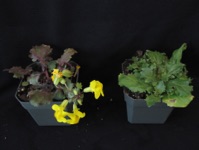Adaptation of Developmental Timing
Photoperiod response adaptation in Wild Sunflower
Genetics of threshold trait evolution in mimulus

As species expand their ranges and colonize new areas, environmental conditions may change dramatically, selecting for the evolution of new developmental responses, alteration of existing responses, or elimination of plasticity altogether. We seek to understand how these processes have occurred historically to gain insight into the genetic architecture of adaptation and speciation, how plasticity may foster or hinder adaptation, and how gene networks are remodeled by evolution.
The common sunflower, Helianthus annuus, inhabits a broad geographical range over which the timing of the growth season varies greatly. Like many species, sunflower exhibits a latitudinal cline in flowering. Notably, it also shows transitions in the response of flowering to photoperiod along this gradient from insensitive to short-day sensitive to long-day sensitive.
In studying the genetic basis and ecological pressures driving this variation, we hope to understand whether natural selection on individual genes varies across environments due to plasticity in gene expression, changes in heritability or genetic architecture, and/or differences in the balance of selective agents in different environments. We have already identified gene expression correlates of this diversity (Blackman et al., 2011). Current work is focused on mapping the loci involved (Henry et al. 2014) so that in the future we may also examine how the joint action of climatic and biotic selection pressures on these loci varies geographically in the field.
Populations of the common monkeyflower, Mimulus guttatus, inhabit diverse habitats throughout western North America. This species is an obligate long-day plant. That is, plants require a certain minimum day length for floral induction. Through surveys of flowering time diversity, we have found that this minimum threshold varies greatly within and between populations (Kooyers et al. 2015). Notably, high elevation populations consistently require longer day lengths to induce flowering than nearby low elevation populations. Through genetic mapping and field studies, the lab is exploring the genetic basis and adaptive value of this variation. in collaboration with Daniel Runcie (University of California, Davis), Jason Sexton (University of California, Merced), and Akiko Satake (Kyushu University), we will also develop transcriptional network-informed models of flowering responses to predict population responses to current and future climates.
The threshold for flowering is less than 13 hours light per day for a low elevation plant (left) but not for a high elevation plant (right)

Plants from higher latitude flower earlier, and how flowering responds to photoperiod cues varies between populations as well.